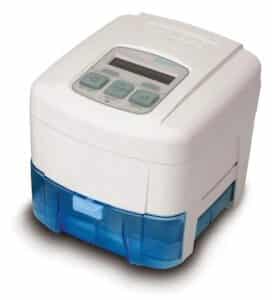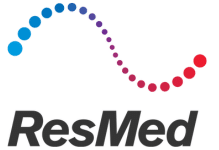3 Best BiPAP Machines in 2025
A quick look at the best BiPAP machines of 2025
- Most Comfortable: ResMed AirCurve 10 VAuto With HumidAir & Heated Tube
- Best for Travel: DeVilbiss IntelliPAP AutoBilevel
- Easiest to Use: React Health Luna G3 25A
While many people are familiar with continuous positive airway pressure (CPAP) machines, bilevel positive airway pressure (BiPAP) machines are another type of device used for positive airway pressure (PAP) therapy. Unlike CPAP machines, which uses the same air pressure regardless of whether someone is breathing in or breathing out, a BiPAP machine releases air at different pressure levels for inhalations and exhalations. That can make exhaling easier. BiPAP machines may be necessary for certain conditions, like chronic obstructive pulmonary disorder (COPD) or sleep apnea, or for people who have tried CPAP therapy with unsuccessful results. [1]Johns Hopkins Medicine. BiPap. Found on the internet at https://www.hopkinsmedicine.org/health/treatment-tests-and-therapies/bipap Your doctor will determine whether BiPAP therapy is necessary for your condition and diagnosis.
BiPAP machines are generally more expensive and less frequently prescribed than CPAP machines, so there aren’t many BiPAP models on the market. With fewer choices, it’s important to consider the options to understand which machine will best suit your needs. For example, frequent travelers may want to research travel CPAP machines before making a purchase. Our team researched the top models to help you understand the features and functions of each device so you can make an informed decision when selecting a BiPAP machine.
Best BiPAP machines of 2025

Note: When traveling by plane, medical devices like BiPAP machines and accessories do not count toward your carry-on luggage limit. [4]Transportation Security Administration. What Can I Bring? Medical. Found on the internet at https://www.tsa.gov/travel/security-screening/whatcanibring/medical The DeVilbiss IntelliPAP AutoBilevel is FAA-compliant, so you can carry it on the plane and use your device during the flight if needed.
What to consider when choosing a BiPAP machine
A BiPAP machine is designed to help you breathe more effectively, usually during sleep. Here are some of the factors to keep in mind when looking into different BiPAP models:
- Prescription: Your prescription and the availability of machines that can accommodate your prescription will determine which devices to consider. Most BiPAP machines have similar pressure ranges, but you’ll need to confirm with your doctor and equipment supplier that the machine you want to purchase is compatible with your prescription.
- Climate control: Options like humidifiers and heated tubing are considered non-essential, but they can minimize or even eliminate BiPAP side effects. By adding moisture to the pressurized air, humidifiers keep your airways from drying out. Heated tubing warms the air, making it more comfortable to breathe.
- Limited choices: Compared with CPAP machines, there simply aren’t many BiPAP models available to purchase. A supplier or retailer that works with your insurance may only have one or two models to offer that work with your prescription, so be prepared for a limited selection.
- Noise level: Consider how lightly you sleep, as well as whether you sleep with a partner. Most modern BiPAP machines are designed to be about as quiet as a whisper, around 25 decibels, but if you or a partner are easily awakened by sounds, look for the quietest model available. A few extra decibels may make a big difference.
- Mask compatibility: Many BiPAP machines are universally compatible with PAP masks. However, there are some masks that only work with certain machines and tubing. If you are an experienced PAP user and have a favorite mask, check with your equipment supplier or the BiPAP manufacturer to confirm compatibility.
- Accessories: A number of accessories may make BiPAP treatment more comfortable or convenient. For example, you can buy special pillows designed to accommodate your headgear and mask, a carrying case if you travel frequently, or features like a humidifier or data tracking accessory.
- Dimensions: It’s important to consider where you will be using your BiPAP machine most often, and whether it will fit in your bedroom. If you have a large table or nightstand next to your bed, you can likely use a machine with larger dimensions. If you plan to travel frequently and will need to bring your BiPAP machine with you, it’s a good idea to look for one that is compact and lightweight.
- Data tracking: Data tracking allows you and your health care team to analyze the efficacy of your BiPAP treatment. Many insurance providers make data tracking a requirement of coverage.
- Insurance coverage: BiPAP machines are expensive, so if you have insurance, make sure you choose a model that’s covered. Call your insurance company before you begin the buying process to confirm your coverage. They’ll be able to provide you with details like which machines are covered and where to purchase your BiPAP.
- Warranty: Most BiPAP machines come with a manufacturer’s warranty, but you should clarify what the warranty covers before making a purchase. Some warranties will offer the same coverage for the unit, power components, and humidifier, while others have different warranty terms for different parts of the machine. Also, manufacturers’ warranties usually only offer coverage for the initial buyer. If you are looking at refurbished or secondhand machines, ask the retailer if they provide any warranty coverage.
How to buy a BiPAP machine
As durable medical equipment that requires a prescription for use, there are specific steps you must take in order to purchase a BiPAP machine.
Diagnosis and prescription for BiPAP use
To buy a BiPAP machine, you need a diagnosis and prescription. There are many reasons you may seek medical care for breathing-related issues. You may have noticed difficulty breathing during sleep or unexplained fatigue while awake. Or a partner may even observe your snoring or breathing abnormalities while you sleep. A common diagnosis requiring a CPAP or BiPAP machine is sleep apnea, but doctors may also prescribe BiPAP therapy for COPD, pneumonia, certain neurological disorders, and post-surgical breathing recovery. [1]Johns Hopkins Medicine. BiPap. Found on the internet at https://www.hopkinsmedicine.org/health/treatment-tests-and-therapies/bipap
Selecting a BiPAP machine and equipment supplier
In most cases, your condition and prescription will determine which machine is right for you. Your doctor may even recommend a specific machine. Once you know the machine (or options) you’re considering, you can decide where to shop.
Note that some insurance plans only offer coverage of equipment purchased from certain suppliers. It’s always important to check with your insurance and confirm coverage before trying to purchase a BiPAP machine. Buying online can offer more options, as online suppliers can ship BiPAP equipment to most locations in the United States. To purchase your BiPAP machine from an online retailer, have your doctor first confirm your prescription with the supplier.
Does Medicare pay for BiPAP machines?
Medicare does cover BiPAP machines, but there are specific terms and restrictions to Medicare coverage. In order for Medicare to cover your BiPAP machine, first you need to have a qualifying diagnosis from your doctor and a prescription for PAP therapy. Your doctor and the equipment supplier you choose must also be enrolled in the Medicare program for your therapy to qualify for coverage.
When you have a diagnosis and prescription for PAP therapy, Medicare covers the cost of BiPAP device rental plus any necessary accessories for a three-month trial period. [5]Medicare.gov. Continuous Positive Airway Pressure (CPAP) devices, accessories, & therapy. Found on the internet at https://www.medicare.gov/coverage/continuous-positive-airway-pressure-devices With this coverage from original Medicare, you will pay 20% of the cost of all equipment and supplies after you’ve reached your Part B deductible.
After the trial period, Medicare will require medical documentation that you still require therapy and that the therapy is helping you. Medicare covers a total rental period of 13 months, including the three-month trial period. When your rental period reaches 13 months, if your usage data shows you’ve used the machine consistently and as prescribed, you will own the machine.
Comparison of the best BiPAP machines, as of 2025
| Price | $1,776 | $1,275 | $1,499 |
| Weight (in pounds) | 2.75 without humidifier; 4 with humidifier | 2.75 without humidifier; 4.45 with humidifier | 3.75 (including built-in humidifier) |
| Dimensions in inches (L x W x H) | 10.04 x 4.57 x 5.91 | 6.5 x 8.4 x 6.4 | 10.4 x 5.7 x 4.5 |
| Noise level (in decibels)* | 27 | 26 | 26 |
| Pressure range | 3–25 cm H2O | 3–25 cm H2O | 4–25 cm H2O |

Note: If CPAP is an option for your condition, some insurance plans, including Medicare, may request that you try CPAP therapy before the plan will provide coverage for BiPAP therapy. Additionally, if your condition doesn’t meet Medicare or insurance requirements for BiPAP reimbursement, you may have to provide additional medical justification for using one, since BiPAP machines are typically more expensive than CPAP machines.
How we chose the best BiPAP machines
Our team consulted with industry experts to better understand the purpose and function of BiPAP therapy and CPAP and BiPAP machines. Based on our expert consultations and research, we determined the following factors to be important for our readers when shopping for a BiPAP machine:
- Cost
- Noise level
- Weight and size dimensions
- Mask compatibility and comfort
- Humidification
- Warranty
- Customer service
We had all of our selections medically reviewed by an expert in the field to ensure that each brand and model is appropriate for our readers’ needs.
Why you can trust our team’s expert review
Our team recommends products and services that we feel strongly about, and that we believe will truly benefit our readers. We’ve spent more than spent over 250 hours researching machines for PAP therapy to give you the most accurate review of each model and brand. To make our selections, we:
- Interviewed industry experts
- Consulted with a respiratory therapist to confirm the accuracy and integrity of our reviews
- Researched 15 manufacturers and 45 models across the category
- Read real reviews from verified customers on trusted third-party sites, including the Better Business Bureau (BBB) and Trustpilot
- Reviewed academic research to better understand the details and benefits of CPAP therapy and how the devices work
Bottom line
The most important thing to consider when shopping for a BiPAP machine is finding one that fits your PAP therapy prescription. Most retailers and medical suppliers have more CPAP machines to choose from than BiPAP machines, but it’s helpful to know beforehand which features may make your BiPAP therapy more comfortable and effective. Always discuss the available machines with your doctor to understand which ones will work for you.

Frequently asked questions
BiPAP is a form of PAP therapy, which stands for “positive airway pressure.” A BiPAP machine is used for maintaining an open airway for effective breathing, usually during sleep. BiPAP machines apply different levels of pressure to keep the airway open while you breathe—higher pressure when you inhale and lower pressure when you exhale.
The average cost of a BiPAP machine is around $1,500. The models featured in this article range from $1,275 to $1,995. Cost can vary with the addition of optional features like heated tubing or enhanced connectivity.
Most BiPAP machines start to show signs of wear and tear around five years, which is when they’re eligible for replacement if you’re using insurance.
CPAP uses a constant flow of air pressure to hold the airway open, regardless of whether you’re inhaling or exhaling. BiPAP uses constant flow to provide two pressure settings—a higher pressure when you breathe in, and a lower pressure when you breathe out. For some people, the lower pressure makes it easier and more comfortable to exhale.
BiPAP is often prescribed for certain conditions like central sleep apnea or COPD. It may also be recommended for people who have trouble tolerating a CPAP machine.
Yes. BiPAP machines increase oxygen levels and help stabilize carbon dioxide levels. That’s why they’re used in emergency situations, such as an attack of COPD symptoms.
Have questions about this review? Email us at reviewsteam@ncoa.org.
Sources
- Johns Hopkins Medicine. BiPap. Found on the internet at https://www.hopkinsmedicine.org/health/treatment-tests-and-therapies/bipap
- ResMed. Device innovation: Our Features & Algorithms. Found on the internet at https://www.resmed.com/en-us/healthcare-professional/products-and-support/innovation-technology/
- Yale.edu. Decibel Level Comparison Chart. Found on the internet at https://ehs.yale.edu/sites/default/files/files/decibel-level-chart.pdf
- Transportation Security Administration. What Can I Bring? Medical. Found on the internet at https://www.tsa.gov/travel/security-screening/whatcanibring/medical
- Medicare.gov. Continuous Positive Airway Pressure (CPAP) Devices, Accessories, & Therapy. Found on the internet at https://www.medicare.gov/coverage/continuous-positive-airway-pressure-devices






